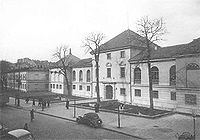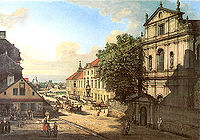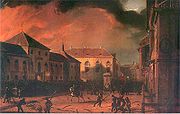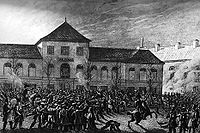
Warsaw Arsenal
Encyclopedia
Warsaw Arsenal is a building of a military arsenal
in Warsaw
, Poland. It is located at Długa street, in the proximity of the Warsaw's Old Town. Throughout the ages the building served a variety of roles. It was the scene of heavy fighting during the Warsaw Insurrection of 1794. Currently it houses the National Museum of Archaeology
.

 The building was constructed in mid-16th century by order of King Stefan Batory
The building was constructed in mid-16th century by order of King Stefan Batory
, initially serving as the war veteran's hostel. During the reign of King Władysław IV of Poland, between 1638 and 1643 the building was thoroughly reconstructed by General of Engineers Paweł Grodzicki (who is also considered the main architect) to suit the needs of a city arsenal (cekhauz, as it was called back then). It received a classicist finish and its walls were thickened in order to allow for its defence against direct attacks. Since then the building served as the main armoury of the Warsaw's garrison. In 18th century it was twice rebuilt, the first time between 1752 and 1754 (by Jan Deybel and Joachim Rauch) and then between 1779 and 1782. The latter modernization of the arsenal was carried over by Szymon Zug and Stanisław Zawadzki, both being among the most renown Polish architects of the epoch.
 During the Warsaw Insurrection of 1794, the building was a scene of heavy fights between the Polish Army and civilians, and the Russian units occupying Warsaw. Damaged during the fights, in 1817 it was rebuilt under leadership of Wilhelm Minter. Following the November Uprising
During the Warsaw Insurrection of 1794, the building was a scene of heavy fights between the Polish Army and civilians, and the Russian units occupying Warsaw. Damaged during the fights, in 1817 it was rebuilt under leadership of Wilhelm Minter. Following the November Uprising
, until 1835 the building was being rebuilt to become a large tsarist prison. However, eventually the Russian authorities decided to build a huge Warsaw Citadel
instead and the arsenal was then converted to a place of temporary detention of common criminals, rather than political prisoners held in the citadel. After Poland regained her independence, the building continued to serve as a police precinct, but was in dire need of renovation. Between 1935 and 1938, during the presidency of Stefan Starzyński
, the arsenal was yet again converted to some other purpose, this time to house the city archive. The main architects, Bruno Zborowski and Andrzej Węgrzecki, decided to restore much of the external design of the courtyard to its original, 17th century outlook.
The building survived the Polish Defensive War
of 1939 and continued to serve its pre-war role during the German occupation of Poland. In the spring of 1943 in front of it the Szare Szeregi
resistance organization conducted one of its most spectacular actions by liberating a number of political prisoners being transferred by the Gestapo from one prison to another. The operation is hence called the Operation Arsenal
. The building then saw heavy fighting during the ill-fated Warsaw Uprising
of 1944 and was one of the Polish redoubts in the area, defending the area of Warsaw's Old Town from the west. Following the capitulation of the uprising, the arsenal was completely destroyed by the Germans, together with the surrounding buildings and the Simmons' passage, one of the most luxurious shopping malls in the inter-war city.
 In 1948 it was decided that the arsenal be rebuilt in its original form. Finishing their work in 1950, the workers rebuilt the building to resemble how it looked like in the 17th century, under the supervision of Bruno Zborowski. Since 1959 it houses the Archaeological Museum of Warsaw.
In 1948 it was decided that the arsenal be rebuilt in its original form. Finishing their work in 1950, the workers rebuilt the building to resemble how it looked like in the 17th century, under the supervision of Bruno Zborowski. Since 1959 it houses the Archaeological Museum of Warsaw.
Arsenal
An arsenal is a place where arms and ammunition are made, maintained and repaired, stored, issued to authorized users, or any combination of those...
in Warsaw
Warsaw
Warsaw is the capital and largest city of Poland. It is located on the Vistula River, roughly from the Baltic Sea and from the Carpathian Mountains. Its population in 2010 was estimated at 1,716,855 residents with a greater metropolitan area of 2,631,902 residents, making Warsaw the 10th most...
, Poland. It is located at Długa street, in the proximity of the Warsaw's Old Town. Throughout the ages the building served a variety of roles. It was the scene of heavy fighting during the Warsaw Insurrection of 1794. Currently it houses the National Museum of Archaeology
National Museum of Archaeology (Poland)
Państwowe Muzeum Archeologiczne w Warszawie is a museum in Warsaw, Poland. It was established in 1923....
.
History


Stefan Batory
Stephen Báthory was a Hungarian noble Prince of Transylvania , then King of Poland and Grand Duke of Lithuania . He was a member of the Somlyó branch of the noble Hungarian Báthory family...
, initially serving as the war veteran's hostel. During the reign of King Władysław IV of Poland, between 1638 and 1643 the building was thoroughly reconstructed by General of Engineers Paweł Grodzicki (who is also considered the main architect) to suit the needs of a city arsenal (cekhauz, as it was called back then). It received a classicist finish and its walls were thickened in order to allow for its defence against direct attacks. Since then the building served as the main armoury of the Warsaw's garrison. In 18th century it was twice rebuilt, the first time between 1752 and 1754 (by Jan Deybel and Joachim Rauch) and then between 1779 and 1782. The latter modernization of the arsenal was carried over by Szymon Zug and Stanisław Zawadzki, both being among the most renown Polish architects of the epoch.

November Uprising
The November Uprising , Polish–Russian War 1830–31 also known as the Cadet Revolution, was an armed rebellion in the heartland of partitioned Poland against the Russian Empire. The uprising began on 29 November 1830 in Warsaw when the young Polish officers from the local Army of the Congress...
, until 1835 the building was being rebuilt to become a large tsarist prison. However, eventually the Russian authorities decided to build a huge Warsaw Citadel
Warsaw Citadel
Cytadela is a 19th-century fortress in Warsaw, Poland. It was built by order of Tsar Nicholas I after the suppression of the 1830 November Uprising in order to bolster imperial Russian control of the city. It served as a prison into the late 1930s.- History :The Citadel was built by personal...
instead and the arsenal was then converted to a place of temporary detention of common criminals, rather than political prisoners held in the citadel. After Poland regained her independence, the building continued to serve as a police precinct, but was in dire need of renovation. Between 1935 and 1938, during the presidency of Stefan Starzyński
Stefan Starzynski
Stefan Starzyński was a Polish politician, economist, writer and statesman, President of Warsaw before and during the Siege of Warsaw in 1939.-Soldier:Starzyński was born on August 19, 1893 in Warsaw...
, the arsenal was yet again converted to some other purpose, this time to house the city archive. The main architects, Bruno Zborowski and Andrzej Węgrzecki, decided to restore much of the external design of the courtyard to its original, 17th century outlook.
The building survived the Polish Defensive War
Invasion of Poland (1939)
The Invasion of Poland, also known as the September Campaign or 1939 Defensive War in Poland and the Poland Campaign in Germany, was an invasion of Poland by Germany, the Soviet Union, and a small Slovak contingent that marked the start of World War II in Europe...
of 1939 and continued to serve its pre-war role during the German occupation of Poland. In the spring of 1943 in front of it the Szare Szeregi
Szare Szeregi
"Gray Ranks" was a codename for the underground Polish Scouting Association during World War II.The wartime organisation was created on 27 September 1939, actively resisted and fought German occupation in Warsaw until 18 January 1945, and contributed to the resistance operations of the Polish...
resistance organization conducted one of its most spectacular actions by liberating a number of political prisoners being transferred by the Gestapo from one prison to another. The operation is hence called the Operation Arsenal
Operation Arsenal
The Operation Arsenal, code name: "Meksyk II" was the first major operation by the Szare Szeregi Polish Underground formation during the Nazi occupation of Poland. It took place on March 26, 1943 in Warsaw...
. The building then saw heavy fighting during the ill-fated Warsaw Uprising
Warsaw Uprising
The Warsaw Uprising was a major World War II operation by the Polish resistance Home Army , to liberate Warsaw from Nazi Germany. The rebellion was timed to coincide with the Soviet Union's Red Army approaching the eastern suburbs of the city and the retreat of German forces...
of 1944 and was one of the Polish redoubts in the area, defending the area of Warsaw's Old Town from the west. Following the capitulation of the uprising, the arsenal was completely destroyed by the Germans, together with the surrounding buildings and the Simmons' passage, one of the most luxurious shopping malls in the inter-war city.


